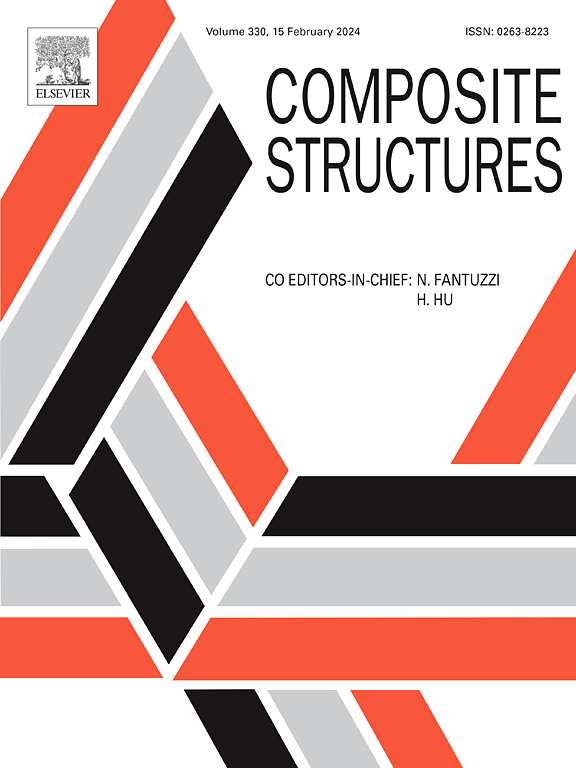Evaluating the elastic wave speed in heterogeneous materials and structures: A concurrent multiscale modeling approach
IF 6.3
2区 材料科学
Q1 MATERIALS SCIENCE, COMPOSITES
引用次数: 0
Abstract
Elastic wave speed is significant for studying materials’ dynamic behavior, and usually evaluated using the classical equations or especially for homogeneous isotropic materials. However, these analytical methods may not be suitable for heterogeneous materials and structures, while the direct numerical simulation (DNS) using finite element method requires a huge number of elements which leads to unmanageable computational cost. To this end, the Direct Finite Element Square (DFE2) method was used to simulate the elastic wave propagation in heterogeneous materials and structures, whereby it was proposed that both meso-scale stress and density should be scaled in the DFE2 method to accurately predict the wave transmission time in heterogeneous materials. Also, it was found that DFE2 method generally predicts a higher elastic wave speed due to the unrealistic wave transmission in the macro-element at the impact end, and the error can be reduced by refining the macro-elements. Simulation of several heterogenous materials such as fiber reinforced polymer composites, anisotropic cellular structures and density-gradient porous panels show that the DFE2 method can capture the elastic wave speed in 2D heterogeneous materials and structures more accurately compared to classical estimation equations, whereby the DNS result was used as reference. Moreover, the DFE2 method exhibits a high computational efficiency, i.e., more than 10 times higher than DNS, and can be easily implemented using available features in commercial software. This implies the valuable potential of the DFE2 method in evaluating the elastic wave speed in heterogeneous materials and structures.
评估异质材料和结构中的弹性波速:并行多尺度建模方法
弹性波速对于研究材料的动力学行为具有重要意义,特别是对于均匀各向同性材料,通常使用经典方程c=E/ρ或c=λ+2μ/ρ来计算。然而,这些分析方法可能不适合非均质材料和结构,而使用有限元方法的直接数值模拟(DNS)需要大量的单元,导致计算成本难以管理。为此,采用直接有限元平方法(Direct Finite Element Square, DFE2)对弹性波在非均质材料和结构中的传播进行模拟,提出在DFE2方法中应同时对细观尺度应力和密度进行缩放,以准确预测波在非均质材料中的传播时间。同时,由于冲击端宏观单元中存在不真实的波传播,DFE2方法通常预测出较高的弹性波速,通过对宏观单元进行细化可以减小误差。对纤维增强聚合物复合材料、各向异性细胞结构和密度梯度多孔板等多种非均质材料的模拟结果表明,与经典估计方程相比,DFE2方法可以更准确地捕获二维非均质材料和结构中的弹性波速,并以此作为参考。此外,DFE2方法具有较高的计算效率,即比DNS高10倍以上,并且可以很容易地利用商业软件中的可用功能实现。这意味着DFE2方法在评估非均质材料和结构中的弹性波速方面具有宝贵的潜力。
本文章由计算机程序翻译,如有差异,请以英文原文为准。
求助全文
约1分钟内获得全文
求助全文
来源期刊

Composite Structures
工程技术-材料科学:复合
CiteScore
12.00
自引率
12.70%
发文量
1246
审稿时长
78 days
期刊介绍:
The past few decades have seen outstanding advances in the use of composite materials in structural applications. There can be little doubt that, within engineering circles, composites have revolutionised traditional design concepts and made possible an unparalleled range of new and exciting possibilities as viable materials for construction. Composite Structures, an International Journal, disseminates knowledge between users, manufacturers, designers and researchers involved in structures or structural components manufactured using composite materials.
The journal publishes papers which contribute to knowledge in the use of composite materials in engineering structures. Papers deal with design, research and development studies, experimental investigations, theoretical analysis and fabrication techniques relevant to the application of composites in load-bearing components for assemblies, ranging from individual components such as plates and shells to complete composite structures.
 求助内容:
求助内容: 应助结果提醒方式:
应助结果提醒方式:


